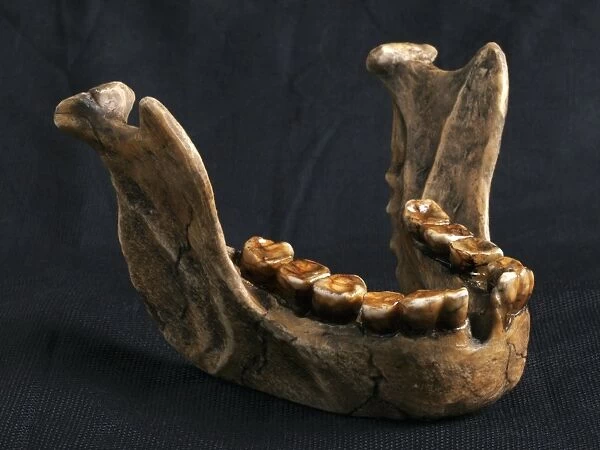Homo floresiensis mandible
![]()

Wall Art and Photo Gifts from Science Photo Library
Homo floresiensis mandible
Homo floresiensis mandible. Mould made from fragments of the mandible (jaw bone) of Homo floresiensis. This newly discovered hominid species was found in 2003 in Liang Bua cave, Flores, Indonesia. It was very small, measuring just over a metre tall, and is thought to be a descendant of Homo erectus that underwent island dwarfism - a process where isolated species that lack predators and are constrained by limited resources evolve to become smaller. It is thought to have become extinct around 12, 000 years ago and therefore co-existed with modern humans (Homo sapiens)
Science Photo Library features Science and Medical images including photos and illustrations
Media ID 6327985
© JAVIER TRUEBA/MSF/SCIENCE PHOTO LIBRARY
Ancestor Anthropological Anthropology Archaeological Archaeology Archeology Bones Cranial Cranium Dwarfism Early Human Early Man Evolution Evolutionary Biology Extinct Flores Flores Man Fossil Fossil Man Fossils Hobbits Hominid Hominids Homo Floresiensis Human Evolution Indonesia Indonesian Island Isolated Jaw Bone Liang Bua Cave Mold Molding Mould Moulding Palaeoanthropology Palaeontological Paleoanthropology Paleontological Pre Historic Pre History Primitive Relative Relatives Remains Short Small Species Dwarfing Hobbit Palaeontology
EDITORS COMMENTS
This print showcases a remarkable discovery in the field of paleoanthropology - the Homo floresiensis mandible. Crafted meticulously from fragments of the actual jaw bone, this mould provides an intriguing glimpse into the life and existence of this newly unearthed hominid species. Discovered in 2003 within the depths of Liang Bua cave, located on Flores Island in Indonesia, Homo floresiensis was a diminutive creature standing just over one meter tall. Believed to be descended from Homo erectus, it underwent a fascinating process known as island dwarfism. This phenomenon occurs when isolated species lacking predators and limited resources evolve to become smaller over time. Coexisting with modern humans until approximately 12,000 years ago, this enigmatic ancestor left behind remnants that continue to captivate archaeologists and anthropologists alike. The intricate details captured in this photograph bring forth a sense of wonder and curiosity about our evolutionary past. As we delve deeper into their history through cranial remains like this mandible mold, we gain valuable insights into early human evolution and our shared lineage with these ancient beings. It serves as a testament to both our collective fascination with prehistoric times and the tireless efforts of those dedicated to unearthing humanity's rich past. Through its depiction here by Science Photo Library, we are reminded once again that there is still much more waiting beneath Earth's surface for us to discover - secrets yet untold that may reshape our understanding of who we are as a species.
MADE IN THE USA
Safe Shipping with 30 Day Money Back Guarantee
FREE PERSONALISATION*
We are proud to offer a range of customisation features including Personalised Captions, Color Filters and Picture Zoom Tools
SECURE PAYMENTS
We happily accept a wide range of payment options so you can pay for the things you need in the way that is most convenient for you
* Options may vary by product and licensing agreement. Zoomed Pictures can be adjusted in the Cart.

